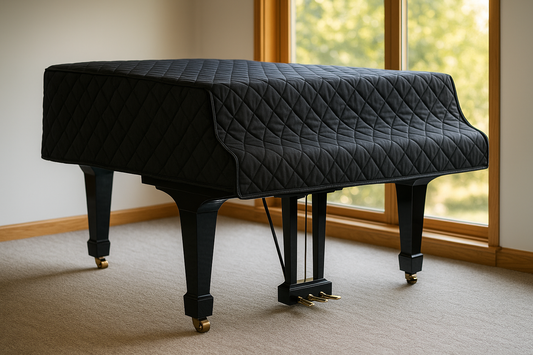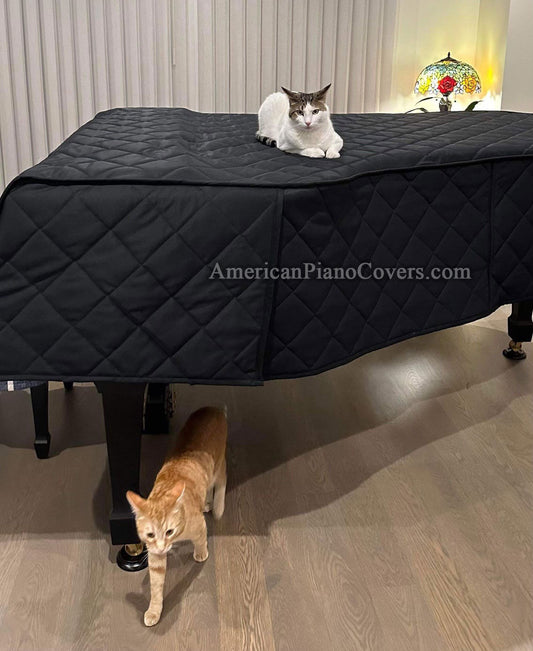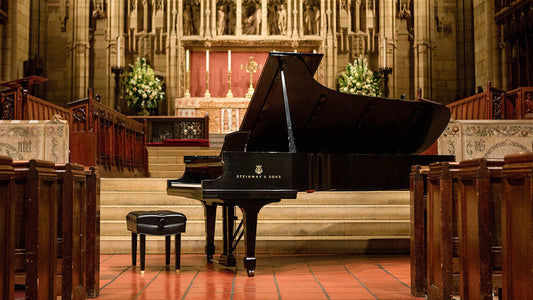Do Piano Covers Protect Against Humidity?
Humidity is one of the most common—but misunderstood—factors affecting a piano’s health. While a cover can’t regulate humidity by itself, the right material helps buffer temperature swings, reduce surface condensation, and prevent sunlight or heating vents from damaging the finish.
At American Piano Covers™, we’ve supplied thousands of covers to homes, schools, and concert halls nationwide. Over three decades, we’ve seen firsthand how choosing the correct material makes all the difference for long-term piano preservation.
How Humidity Affects Your Piano
- Soundboard expansion and contraction cause tuning instability.
- Moisture in the action leads to sluggish touch and sticking keys.
- Heat and trapped moisture can soften or crack the lacquer finish.
In short, stable humidity = stable piano.
Understanding the Role of a Piano Cover
A piano cover’s primary purpose is to shield your instrument from dust, sunlight, and physical wear. However, depending on the material, it can also provide a moderate barrier against humidity and temperature fluctuations.
At American Piano Covers™, our materials range from vinyl to heavy-duty quilted mackintosh. Each option offers a different level of insulation and breathability—factors that directly affect how the cover interacts with humidity.
Can a Piano Cover Help?
Yes — but it’s not a dehumidifier.
A good cover slows rapid environmental changes by acting as a thermal and dust buffer. The key is to match the material to your room’s environment.
Breathability vs. Sealing: Which Is Better?
There’s a common misconception that you want to “seal in” the piano to protect it from humidity. In reality, trapping air inside the cover can actually create condensation if the environment fluctuates between warm and cool temperatures.
That’s why our Premium Quilted Nylon covers are ideal for pianos in variable environments. These materials breathe just enough to prevent moisture buildup while still protecting from dust and sunlight.
If your piano sits near a window or in direct sunlight, these breathable quilted options are especially recommended—they prevent heat and humidity from becoming trapped under the cover.
When a Tighter Seal Makes Sense
If your piano uses a Dampp-Chaser or Piano Life Saver System, which regulates humidity internally, a tighter-fitting cover can actually help that system maintain a stable environment.
For these cases, our Vinyl or heavy-duty quilted materials are excellent choices—they create a more enclosed seal to help the Dampp-Chaser unit do its job efficiently.
Pro Tip: If you’re using a Dampp-Chaser / Piano Life Saver, request a floor-length option to help retain the controlled humidity inside the piano’s micro-environment.
Floor-Length Covers for Extra Protection
In especially humid or coastal regions, you may also want to consider a floor-length piano cover. This style provides protection all the way to the floor, reducing the amount of ambient air that reaches the piano’s soundboard and internal components. It’s especially useful for homes with tile or concrete floors, which can release moisture upward into the instrument. IF you are interested in a full length cover, please email us for a quote.
Our Recommendations
For humid homes or rooms exposed to sunlight, we recommend our Premium Quilted Nylon Piano Covers. It breathes more than the other pianos, and will not trap the heat or moisture inside the piano. The cover will also help insulate the piano from relative humidity swings and surface condensation.
If your piano sits near a window or in direct sunlight, our Premium Quilted Piano Covers offer breathable protection without trapping heat.
Summary
Piano covers can’t remove humidity — but they do slow damaging environmental shifts. For most homes, breathable quilted covers are safest.
If your piano uses a Dampp-Chaser humidity-control system, a vinyl or mackintosh floor-length cover works best to keep the system efficient and the instrument stable.
When paired with proper humidity management, your cover becomes an important line of defense against cracking finishes, tuning drift, and premature wear.
Key takeaway: For most homes, a breathable quilted cover offers the best year-round balance of humidity protection and airflow.
For a detailed breakdown of how different materials perform, see our Piano Cover Material Comparison
For help choosing the right fabric and build for your piano, see our comprehensive Piano Cover Purchasing Guide





